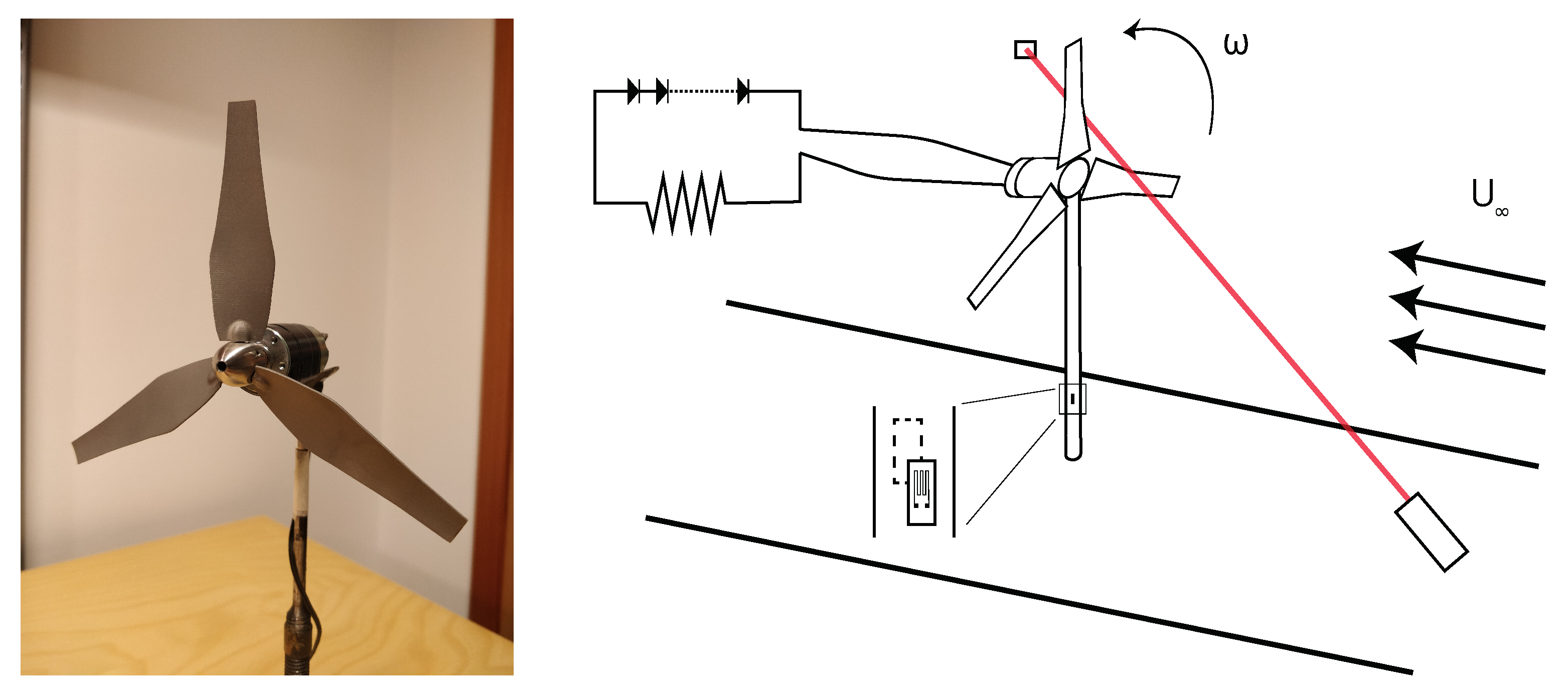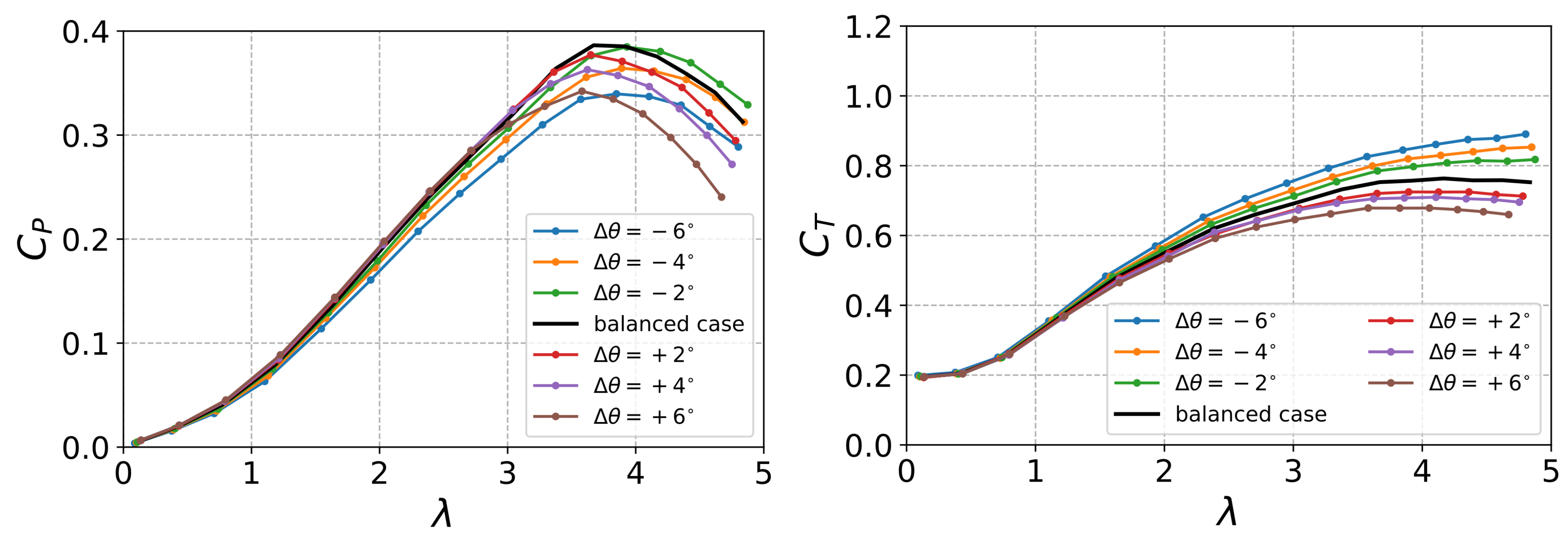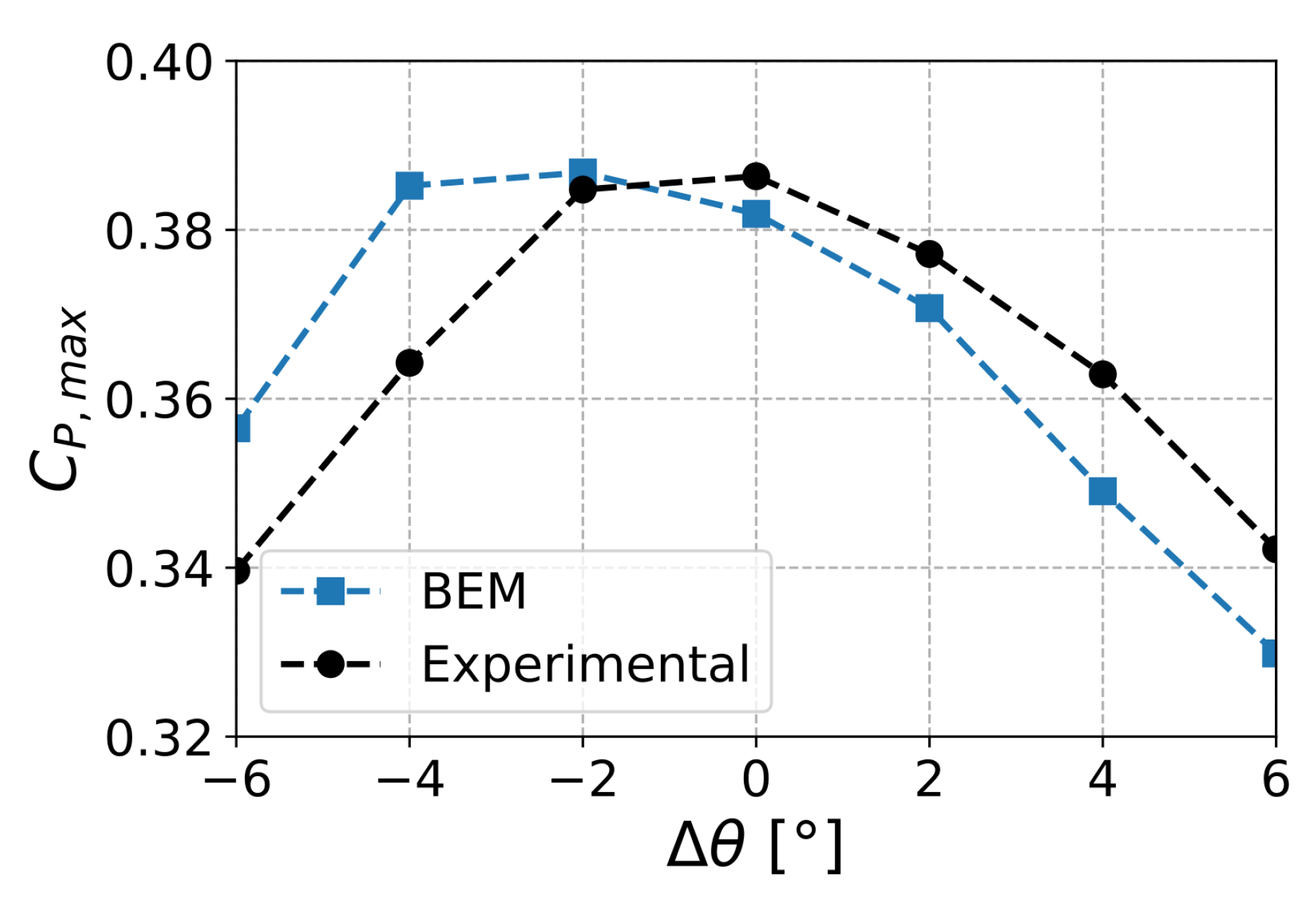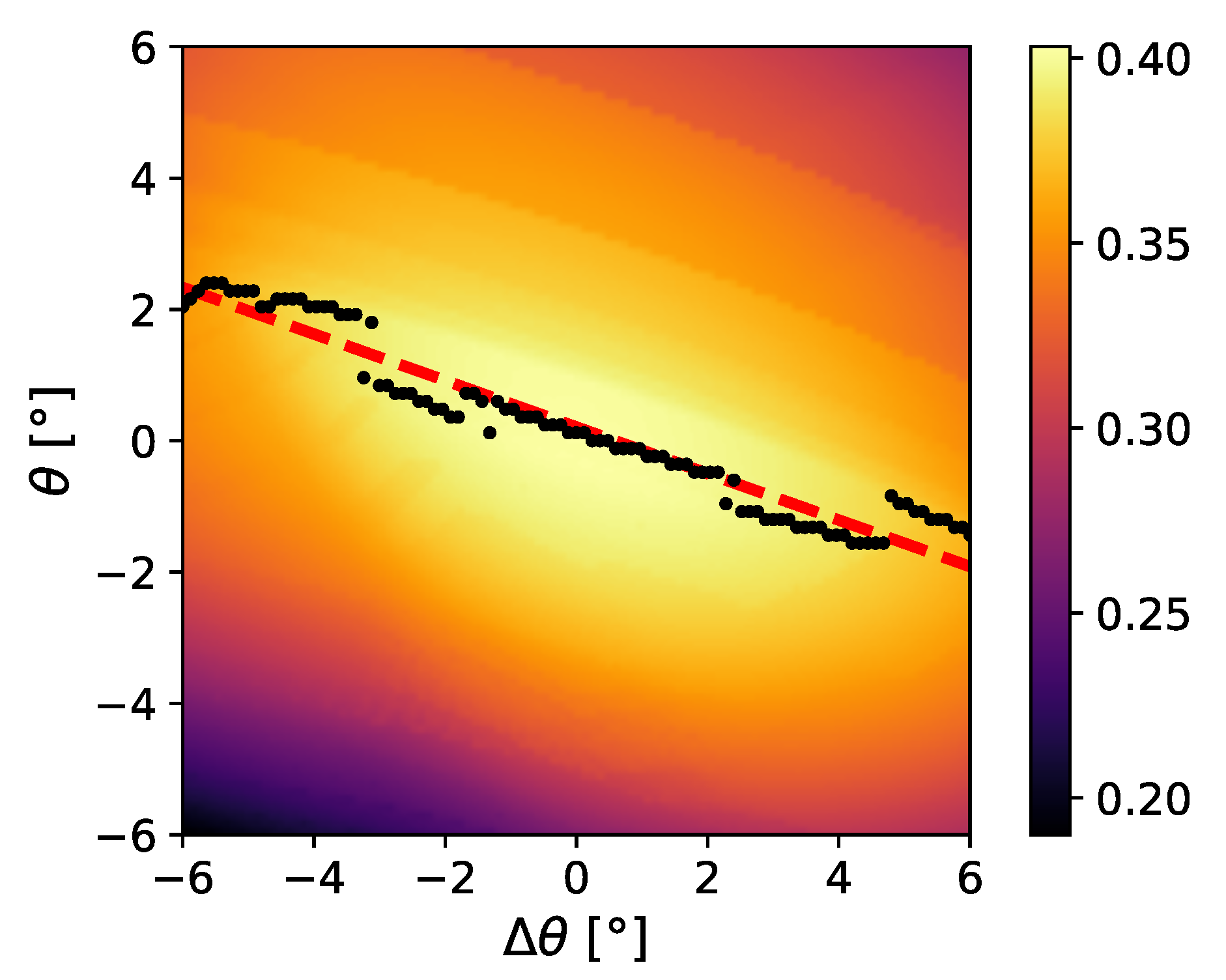An Experimental Study on a Wind Turbine Rotor Affected by Pitch Imbalance
Abstract
:1. Introduction
2. Unbalanced BEM Theory
3. Experimental Methods
Blade Pitch Angle and Measurement
4. Numerical Methods
5. Results and Discussion
5.1. Variable Unbalanced Pitch
5.2. BEM Validation
5.3. Vibration Analysis
6. Conclusions
Author Contributions
Funding
Data Availability Statement
Acknowledgments
Conflicts of Interest
References
- Wagner, R.; Antoniou, I.; Pedersen, S.M.; Courtney, M.S.; Jørgensen, H.E. The influence of the wind speed profile on wind turbine performance measurements. Wind Energy 2009, 12, 348–362. [Google Scholar] [CrossRef]
- Adaramola, M.S.; Krogstad, P. Experimental investigation of wake effects on wind turbine performance. Renew. Energy 2011, 36, 2078–2086. [Google Scholar] [CrossRef]
- Segalini, A.; Alfredsson, P.H. A simplified vortex model of propeller and wind turbine wakes. J. Fluid Mech. 2013, 725, 91–116. [Google Scholar] [CrossRef]
- Hyvärinen, A.; Segalini, A. Effects From Complex Terrain on Wind-Turbine Performance. J. Energy Resour. Technol. 2017, 139. [Google Scholar] [CrossRef]
- Hyvärinen, A.; Segalini, A. Qualitative analysis of wind turbine wakes over hilly terrain. J. Phys. Conf. Ser. 2017, 854, 012023. [Google Scholar] [CrossRef] [Green Version]
- Hyvärinen, A.; Lacagnina, G.; Segalini, A. A wind-tunnel study of the wake development behind wind turbines over sinusoidal hills. Wind Energy 2018, 21, 605–617. [Google Scholar] [CrossRef] [Green Version]
- Shapiro, C.R.; Gayme, D.F.; Meneveau, C. Modelling yawed wind turbine wakes: A lifting line approach. J. Fluid Mech. 2018, 841, R1. [Google Scholar] [CrossRef] [Green Version]
- Bastankhah, M.; Porté-Agel, F. Experimental and theoretical study of wind turbine wakes in yawed conditions. J. Fluid Mech. 2016, 806, 506–541. [Google Scholar] [CrossRef]
- Segalini, A. An analytical model of wind-farm blockage. J. Renew. Sustain. Energy 2021, 13, 033307. [Google Scholar] [CrossRef]
- Segalini, A.; Dahlberg, J. Blockage effects in wind farms. Wind Energy 2020, 23, 120–128. [Google Scholar] [CrossRef]
- Stevens, R.J.; Gayme, D.F.; Meneveau, C. Effects of turbine spacing on the power output of extended wind-farms. Wind Energy 2016, 19, 359–370. [Google Scholar] [CrossRef] [Green Version]
- Burton, T.; Jenkins, N.; Sharpe, D.; Bossanyi, E. Wind Energy Handbook, 2nd ed.; John Wiley & Sons, Ltd.: Hoboken, NJ, USA, 2011. [Google Scholar]
- Anderson, C. Wind Turbines: Theory and Practice; Cambridge University Press: Cambridge, UK, 2020. [Google Scholar]
- Piqué, A.; Miller, M.A.; Hultmark, M. Laboratory investigation of the near and intermediate wake of a wind turbine at very high Reynolds numbers. Exp. Fluids 2022, 63, 106. [Google Scholar] [CrossRef]
- Miller, M.A.; Kiefer, J.; Westergaard, C.; Hansen, M.O.L.; Hultmark, M. Horizontal axis wind turbine testing at high Reynolds numbers. Phys. Rev. Fluids 2019, 4, 110504. [Google Scholar] [CrossRef]
- Chamorro, L.; Arndt, R.; Sotiropoulos, F. Reynolds number dependence of turbulence statistics in the wake of wind turbines. Wind Energy 2012, 15, 733–742. [Google Scholar] [CrossRef]
- Odemark, Y.; Fransson, J.H.M. The stability and development of tip and root vortices behind a model wind turbine. Exp. Fluids 2013, 54, 1597. [Google Scholar] [CrossRef]
- Medici, D.; Alfredsson, P.H. Measurements on a wind turbine wake: 3D effects and bluff body vortex shedding. Wind Energy 2006, 9, 219–236. [Google Scholar] [CrossRef]
- Bastankhah, M.; Porté-Agel, F. A New Miniature Wind Turbine for Wind Tunnel Experiments. Part I: Design and Performance. Energies 2017, 10, 908. [Google Scholar] [CrossRef] [Green Version]
- Bastankhah, M.; Porté-Agel, F. A New Miniature Wind Turbine for Wind Tunnel Experiments. Part II: Wake Structure and Flow Dynamics. Energies 2017, 10, 923. [Google Scholar] [CrossRef] [Green Version]
- Rocha, P.A.C.; Araujo, J.W.C.d.; Lima, R.J.P.; Silva, M.E.V.d.; Albiero, D.; Andrade, C.F.d.; Carneiro, F.O.M. The effects of blade pitch angle on the performance of small-scale wind turbine in urban environments. Energy 2018, 148, 169–178. [Google Scholar] [CrossRef]
- Lackner, M.A. An investigation of variable power collective pitch control for load mitigation of floating offshore wind turbines. Wind Energy 2013, 16, 435–444. [Google Scholar] [CrossRef]
- Niebsch, J.; Ramlau, R.; Nguyen, T.T. Mass and Aerodynamic Imbalance Estimates of Wind Turbines. Energies 2010, 3, 696–710. [Google Scholar] [CrossRef] [Green Version]
- Jasinski, W.J.; Noe, S.C.; Selig, M.S.; Bragg, M.B. Wind Turbine Performance Under Icing Conditions. J. Sol. Energy Eng. 1998, 120, 60–65. [Google Scholar] [CrossRef] [Green Version]
- Lamraoui, F.; Fortin, G.; Benoit, R.; Perron, J.; Masson, C. Atmospheric icing impact on wind turbine production. Cold Reg. Sci. Technol. 2014, 100, 36–49. [Google Scholar] [CrossRef]
- Castellani, F.; Eltayesh, A.; Becchetti, M.; Segalini, A. Aerodynamic Analysis of a Wind-Turbine Rotor Affected by Pitch Unbalance. Energies 2021, 14, 745. [Google Scholar] [CrossRef]
- Cacciola, S.; Agud, I.M.; Bottasso, C.L. Detection of rotor imbalance, including root cause, severity and location. J. Phys. Conf. Ser. 2016, 753, 072003. [Google Scholar] [CrossRef]
- Bertelè, M.; Bottasso, C.L.; Cacciola, S. Automatic detection and correction of pitch misalignment in wind turbine rotors. Wind Energy Sci. 2018, 3, 791–803. [Google Scholar] [CrossRef] [Green Version]
- Bai, C.J.; Wang, W.C. Review of computational and experimental approaches to analysis of aerodynamic performance in horizontal-axis wind turbines (HAWTs). Renew. Sustain. Energy Rev. 2016, 63, 506–519. [Google Scholar] [CrossRef]
- Yang, H.; Shen, W.; Xu, H.; Hong, Z.; Liu, C. Prediction of the wind turbine performance by using BEM with airfoil data extracted from CFD. Renew. Energy 2014, 70, 107–115. [Google Scholar] [CrossRef]
- Segalini, A.; Inghels, P. Confinement effects in wind turbine and propeller measurements. J. Fluid Mech. 2014, 756, 110–129. [Google Scholar] [CrossRef]
- Douvi, C.E.; Tsavalos, I.A.; Margaris, P.D. Evaluation of the turbulence models for the simulation of the flow over a National Advisory Committee for Aeronautics (NACA) 0012 airfoil. J. Mech. Eng. Res. 2012, 4, 100–111. [Google Scholar]
- Abbot, I.H.; Von Doenhoff, A.E. Theory of Wind Sections, 2nd ed.; Dover Publications, Inc.: Mineola, NY, USA, 1959. [Google Scholar]
- Miley, S.J. Catalog of Low-Reynolds-Number Airfoil Data for Wind-Turbine Applications; Rockwell International Corp.: Golden, CO, USA, 1982. [Google Scholar] [CrossRef]
- Viterna, L.A.; Janetzke, D.C. Theoretical and Experimental Power from Large Horizontal-Axis Wind Turbines; National Aeronautics and Space Administration: Cleveland, OH, USA, 1982. [CrossRef]














| Parameter | Value | Region | Boundary Condition |
|---|---|---|---|
| Chord (c) | m | Semi-circle inlet | Inlet velocity |
| Domain height | Side walls | Inlet velocity | |
| Domain length | Downstream wall | Pressure outlet | |
| Airfoil surface | No-slip condition | ||
| Number of elements | 88,320 | ||
| Number of nodes | 89,322 | ||
| Minimum face area | |||
| Maximum face area |
Publisher’s Note: MDPI stays neutral with regard to jurisdictional claims in published maps and institutional affiliations. |
© 2022 by the authors. Licensee MDPI, Basel, Switzerland. This article is an open access article distributed under the terms and conditions of the Creative Commons Attribution (CC BY) license (https://creativecommons.org/licenses/by/4.0/).
Share and Cite
Mazzeo, F.; Micheletto, D.; Talamelli, A.; Segalini, A. An Experimental Study on a Wind Turbine Rotor Affected by Pitch Imbalance. Energies 2022, 15, 8665. https://doi.org/10.3390/en15228665
Mazzeo F, Micheletto D, Talamelli A, Segalini A. An Experimental Study on a Wind Turbine Rotor Affected by Pitch Imbalance. Energies. 2022; 15(22):8665. https://doi.org/10.3390/en15228665
Chicago/Turabian StyleMazzeo, Francesco, Derek Micheletto, Alessandro Talamelli, and Antonio Segalini. 2022. "An Experimental Study on a Wind Turbine Rotor Affected by Pitch Imbalance" Energies 15, no. 22: 8665. https://doi.org/10.3390/en15228665
APA StyleMazzeo, F., Micheletto, D., Talamelli, A., & Segalini, A. (2022). An Experimental Study on a Wind Turbine Rotor Affected by Pitch Imbalance. Energies, 15(22), 8665. https://doi.org/10.3390/en15228665








